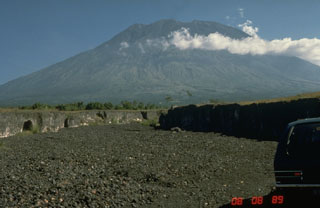Report on Agung (Indonesia) — 4 July-10 July 2018
Smithsonian Institution / US Geological Survey
Weekly Volcanic Activity Report, 4 July-10 July 2018
Managing Editor: Sally Sennert.
Please cite this report as:
Global Volcanism Program, 2018. Report on Agung (Indonesia) (Sennert, S, ed.). Weekly Volcanic Activity Report, 4 July-10 July 2018. Smithsonian Institution and US Geological Survey.
Agung
Indonesia
8.343°S, 115.508°E; summit elev. 2997 m
All times are local (unless otherwise noted)
PVMBG reported that the eruption at Agung continued during 4-10 July. Sulfur dioxide flux was 1,400-2,400 tons/day on 3 July and 400-1,500 tons/day on 4 July. Satellite data acquired on 4 July indicated continuing lava effusion in the crater, with 4-5 million cubic meters effused in the past week. At 1220 an ash plume rose 2.5 km above the crater rim and drifted W. An event was detected at 2216, though an ash plume was not visible possibly due to poor viewing conditions. At 0047 on 5 July an ash plume rose at least 1 km and drifted W, and an event at 1633 produced an ash plume that rose 2.8 km and drifted E and W. A small event was detected on 6 July. According to BNPB a third Strombolian event occurred at 0522 on 8 July, generating an ash plume that rose 2 km. They noted that 4,415 evacuees were housed in 54 evacuation centers. An ash plume rose from the crater at 1120 on 9 July and drifted W. The Alert Level remained at 3 (on a scale of 1-4) and the exclusion zone was stable at a 4-km radius.
Geological Summary. Symmetrical Agung stratovolcano, Bali's highest and most sacred mountain, towers over the eastern end of the island. The volcano, whose name means "Paramount," rises above the SE rim of the Batur caldera, and the northern and southern flanks extend to the coast. The summit area extends 1.5 km E-W, with the high point on the W and a steep-walled 800-m-wide crater on the E. The Pawon cone is located low on the SE flank. Only a few eruptions dating back to the early 19th century have been recorded in historical time. The 1963-64 eruption, one of the largest in the 20th century, produced voluminous ashfall along with devastating pyroclastic flows and lahars that caused extensive damage and many fatalities.
Sources: Pusat Vulkanologi dan Mitigasi Bencana Geologi (PVMBG, also known as CVGHM), Badan Nacional Penanggulangan Bencana (BNPB)

